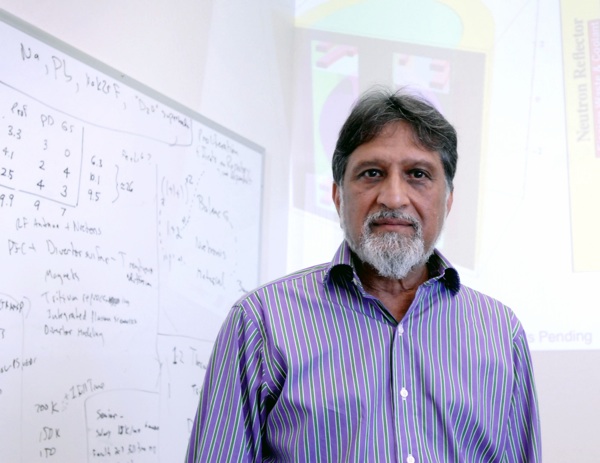Physicist Swadesh Mahajan may have identified a mechanism that can explain the origin of magnetic fields in the universe.
 AUSTIN, Texas—By re-examining the “cosmic fluid” of the early universe through the lens of special relativity, a physicist from The University of Texas at Austin may have identified a mechanism that can explain the origin of magnetic fields in the universe.
AUSTIN, Texas—By re-examining the “cosmic fluid” of the early universe through the lens of special relativity, a physicist from The University of Texas at Austin may have identified a mechanism that can explain the origin of magnetic fields in the universe.
Magnetic fields are everywhere. They permeate the cosmos. They surround the Earth. A great deal about how magnetism works, including how an existing magnetic field can be amplified, is well understood. But the search for the seed that needs to be amplified has posed a serious challenge in theoretical physics.
“We are all trying to construct a story, the origin story, of how the universe came to be as it is,” says Dr. Swadesh Mahajan, of the Institute for Fusion Studies, whose discovery was published in the August 27 issue of Physical Review Letters. “What we’ve done, perhaps, is to identify an essential element in the early chapter in that story. Of course we’ll never know for sure, since we can’t run the universe again.”
Historically, says Mahajan, the difficulty that theoretical physicists have had in explaining magnetism has come from the fact that two incompatible things have seemed to be true. One is that for magnetism to be as ubiquitous as it is, its creation must have been intrinsic to the “ideal dynamics” of the forces present in the early universe.
The other constraint has been that, according to everything we’ve known about fluid mechanics, that’s simply not possible. In an ideal state, there’s what’s known as a “topological constraint.” You can’t generate the rotational force of magnetism, its vorticity, from a state of no vorticity.
Other physicists have tried to get around this problem by looking at non-ideal states, at instances in which some external force—the shockwaves of an exploding supernova, for example—intercedes to break the constraint. And such mechanisms, says Mahajan, can explain some of the magnetism in the universe, but they’re too specific and often too weak to explain the extent and universality of observed magnetism.
So Mahajan and his colleague, Dr. Zensho Yoshida of the University of Tokyo, went back to look at the ideal dynamics from a new angle. They wanted to see if, in fact, they could get around the topological constraint if they looked at the situation not in three dimensions, as has traditionally been done, but in the four-dimensional space-time of special relativity.
“There is a history to it,” says Mahajan. “All these considerations of topological constraints developed in classical non-relativistic fluid mechanics. Within that framework this constraint was forbidding. There had to be conservation of generalized vorticity. So then our question was: Does it change when you go from the three-dimensional space and one dimensional time to the three-plus-one coupled space time. Does that introduce some mechanism so that such a constraint could be broken?”
Working with a set of fully relativistic equations developed to unify electromagnetic fields with fluid dynamics, Mahajan and Yoshida discovered what they call a “relativistic drive” that can, in fact, generate magnetic fields from the kinds of thermal and kinetic energy that exist in ideal conditions.
“Maybe the simplest way of phrasing it,” says Mahajan, “is that the three dimensional projection of a four dimensional conservation law does not have a conservation law in three dimensions.”
Although Mahajan and Yoshida are confident of their calculations—“this is conservative math,” says Mahajan—a number of further steps will likely have to occur before their chapter in the origin story achieves broad acceptance. First, they hope to collaborate with other, more computationally-oriented colleagues to run the kinds of relativistic simulations that can only be done on supercomputers. Eventually, they’d like to see a laboratory experiment that would use high-energy lasers to recreate, on a smaller scale, the actual forces and dynamics they believe created magnetism in the first place.
“The story will never be fully unraveled,” says Mahajan, “but I think we might have found a small part of the answer. Whether it fans out and does lead to the experimental results that are eventually tested and tried, I can’t say. But what we think we have been able to do is isolate a mechanism that is both deep and universal.”

















Comments 1
Many thanks to Dr. Swadesh Mahajan, of the Institute for Fusion Studies for your most important discovery on the origin of magnetic fields in the universe.
In very early universe during its birth, photons were responsible to create all matters and with magnetic properties. Gravitational force occurred by graviton particles. I explained all from the particle to the universe in my book: “Complete Unified Theory” (Page – 424, 1998), I find that if m (1) and m (2) is able to emit 10^6 photons individually at excited state, and if we put this value in Coulomb`s law for m (1) and m (2), than we can get 9.4456x10^-24 joule (when energy of a photon will 9.309x10^-22 ev. This energy almost same to magnetic momentum, 9.2847x10^-24 Joule / T.
Because, I find the accurate mass of a photon. The equation of mass of a photon through the relativity of Einstein brings “The Equation of Unification of Physics” and with effect of gravitational force & graviton, Complete Unified Theory is found. This is single theory. With the help of this theory, I calculated different properties, structure of electron, EMR, birth of magnetism, particles, stars, galaxies, real reason of emission of energy or absorption, quantum circulation of black hole, photosynthesis of plant, accurate energy of Higgs-Boson particle, quarks, Curie particle which is related to all sub-atomic particles (till unknown), maximum mass of the universe etc.
Nirmalendu Das.
Dated: 18-09-2013. Mob: India 9475089337.